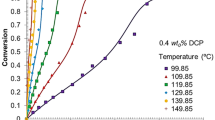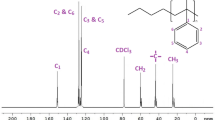Abstract
Atom-transfer radical polymerization (ATRP) is a powerful reversible-deactivation radical polymerization technique that provides polymers with several macromolecular architectures. Global optimization of this type of system is often difficult due to the mathematical models complexity. Based on that, the purpose of this paper is to provide a simplified optimization method to determine the best reaction conditions in bulk styrene ATRP initiated by 2,2,2-tribromoethanol. A kinetic model, with experimental validation, was used to generate the response variables in a full 23 factorial design. Thus, an easy statistic modeling was employed to optimize reaction conditions. It was also performed a traditional global dynamic optimization to prove that our approach could be accomplished without considerable errors. Finally, we demonstrated that the optimum conditions can be obtained in an easy and uncomplicated way, allowing extend it to any polymeric system.





Similar content being viewed by others
References
Nie Z, Kumacheva E (2008) Patterning surfaces with functional polymers. Nature 7:277–290
Zhao M, Zhang H, Ma F et al (2013) Efficient synthesis of monodisperse, highly crosslinked, and “living” functional polymer microspheres by the ambient temperature iniferter-induced “living” radical precipitation polymerization. J Polym Sci Part A Polym Chem 51:1983–1998. doi:10.1002/pola.26579
Lessard BH, Marić M (2013) Water-soluble/dispersible carbazole-containing random and block copolymers by nitroxide-mediated radical polymerisation. Can J Chem Eng 91:618–629. doi:10.1002/cjce.21676
Toloza Porras C, D’hooge DR, Van Steenberge PHM et al (2013) A theoretical exploration of the potential of ICAR ATRP for one- and two-pot synthesis of well-defined diblock copolymers. Macromol React Eng 7:311–326. doi:10.1002/mren.201200085
Zhou Y-N, Li J-J, Luo Z-H (2012) Synthesis of gradient copolymers with simultaneously tailor-made chain composition distribution and glass transition temperature by semibatch ATRP: from modeling to application. J Polym Sci Part A Polym Chem 50:3052–3066. doi:10.1002/pola.26091
Goldmann AS, Glassner M, Inglis AJ, Barner-Kowollik C (2013) Post-functionalization of polymers via orthogonal ligation chemistry. Macromol Rapid Commun 34:810–849. doi:10.1002/marc.201300017
Salian VD, Byrne ME (2013) Living radical polymerization and molecular imprinting: improving polymer morphology in imprinted polymers. Macromol Mater Eng 298:379–390. doi:10.1002/mame.201200191
Yamago S, Yamada T, Togai M et al (2009) Synthesis of structurally well-defined telechelic polymers by organostibine-mediated living radical polymerization: in situ generation of functionalized chain-transfer agents and selective omega-end-group transformations. Chemistry 15:1018–1029. doi:10.1002/chem.200801754
Hardy CG, Ren L, Zhang J, Tang C (2012) Side-chain metallocene-containing polymers by living and controlled polymerizations. Isr J Chem 52:230–245. doi:10.1002/ijch.201100110
Badri A, Whittaker MR, Zetterlund PB (2012) Modification of graphene/graphene oxide with polymer brushes using controlled/living radical polymerization. J Polym Sci Part A Polym Chem 50:2981–2992. doi:10.1002/pola.26094
Dirany M, Lacroix-Desmazes P, Vayer M et al (2011) Polystyrene-block-polylactide obtained by the combination of atom transfer radical polymerization and ring-opening polymerization with a commercial dual initiator. J Appl Polym Sci 122:2944–2951. doi:10.1002/app
Vieira RP, Ossig A, Perez JM et al (2015) Styrene ATRP using the new initiator 2,2,2-tribromoethanol: experimental and simulation approach. Polym Eng Sci 55:2270–2276. doi:10.1002/pen24113
Van Steenberge PHM, D’hooge DR, Wang Y et al (2012) Linear gradient quality of ATRP copolymers. Macromolecules 45:8519–8531. doi:10.1021/ma3017597
Wang L, Broadbelt LJ (2009) Explicit sequence of styrene/methyl methacrylate gradient copolymers synthesized by forced gradient copolymerization with nitroxide-mediated controlled radical polymerization. Macromolecules 42:7961–7968. doi:10.1021/ma901298h
Vieira RP, Ossig A, Perez JM et al (2013) Simulation of the equilibrium constant effect on the kinetics and average properties of polystyrene obtained by ATRP. J Braz Chem Soc 24:2008–2014. doi:10.5935/0103-5053.20130251
Zhu S (1999) Modeling of molecular weight development in atom transfer radical polymerization. Macromol Theory Simul 8:29–37. doi:10.1002/(SICI)1521-3919(19990101)8:1<29:AID-MATS29>3.3.CO;2-Z
D’hooge DR, Reyniers M-F, Marin GB (2009) Methodology for kinetic modeling of atom transfer radical polymerization. Macromol React Eng 3:185–209. doi:10.1002/mren.200800051
Zhang M, Ray WH (2002) Modeling of living free-radical polymerization processes. I. Batch, semibatch, and continuous tank reactors. J Appl Polym Sci 86:1630–1662. doi:10.1002/app.11051
Hernández-Ortiz JC, Jaramillo-Soto G, Palacios-Alquisira J, Vivaldo-Lima E (2010) Modeling of polymerization kinetics and molecular weight development in the microwave-activated RAFT polymerization of styrene. Macromol React Eng 4:210–221. doi:10.1002/mren.200900047
Berkenwald E, Spies C, Cortez JRC et al (2013) Mathematical model for the bulk polymerization of styrene using the symmetrical cyclic trifunctional initiator diethyl ketone triperoxide. I. Chemical initiation by sequential decomposition. J Appl Polym Sci 128:776–786. doi:10.1002/app.38221
Ray WH (1972) On the mathematical modeling of polymerization reactors. J Macromol Sci Part C Polym Rev 8:1–56. doi:10.1080/15321797208068168
Konkolewicz D, Matyjaszewski K (2015) Catalyst activity in ATRP, determining conditions for well-controlled polymerizations. In: Matyjaszewski K, Sumerlin BS, Tsarevsky NV, Chiefari J (eds) ACS symposium series. American Chemical Society, Washington, pp 87–103
Hindmarsh AC (1983) ODEPACK, A systematized collection of ODE solvers. Sci Comput 1:55–64
Zapata-González I, Saldívar-Guerra E, Flores-Tlacuahuac A et al (2012) Efficient numerical integration of stiff differential equations in polymerisation reaction engineering: computational aspects and applications. Can J Chem Eng 90:804–823. doi:10.1002/cjce.21656
Shipp DA, Matyjaszewski K (1999) Kinetic analysis of controlled/“living” radical polymerizations by simulations. 1. The importance of diffusion-controlled reactions. Macromolecules 32:2948–2955. doi:10.1021/ma9819135
Konkolewicz D, Krys P, Matyjaszewski K (2014) Explaining unexpected data via competitive equilibria and processes in radical reactions with reversible deactivation. Acc Chem Res 47:3028–3036. doi:10.1021/ar500199u
D’hooge DR, Reyniers M-F, Marin GB (2013) The crucial role of diffusional limitations in controlled radical polymerization. Macromol React Eng 7:362–379. doi:10.1002/mren.201300006
Fu Y, Mirzaei A, Cunningham MF, Hutchinson RA (2007) Atom-transfer radical batch and semibatch polymerization of styrene. Macromol React Eng 1:425–439. doi:10.1002/mren.200700010
Belincanta-Ximenes J, Mesa PVR, Lona LMF et al (2007) Simulation of styrene polymerization by monomolecular and bimolecular nitroxide-mediated radical processes over a range of reaction conditions. Macromol Theory Simul 16:194–208. doi:10.1002/mats.200600063
Hui AW, Hamielec AE (1972) Thermal polymerization of styrene at high conversions and temperatures. An experimental study. J Appl Polym Sci 16:749–769
Fischer H, Paul H (1987) Rate constants for some prototype radical reactions in liquids by kinetic electron spin resonance. Acc Chem Res 20:200–206
Tang W, Matyjaszewski K (2007) Effects of initiator structure on activation rate constants in ATRP. Macromolecules 40:1858–1863. doi:10.1021/ma062897b
Toloza Porras C, D’hooge DR, Reyniers M-F, Marin GB (2013) Computer-aided optimization of conditions for fast and controlled ICAR ATRP of n-butyl acrylate. Macromol Theory Simul 22:136–149. doi:10.1002/mats.201200074
Singh P, Srivastava A, Kumar R (2012) Synthesis of amphiphilic poly(N-vinylcaprolactam) using ATRP protocol and antibacterial study of its silver nanocomposite. J Polym Sci Part A Polym Chem 50:1503–1514. doi:10.1002/pola.25911
Seeliger F, Matyjaszewski K (2009) Temperature effect on activation rate constants in ATRP: new mechanistic insights into the activation process. Macromolecules 42:6050–6055. doi:10.1021/ma9010507
Chambard G, Klumperman B, German AL (2002) Experimental determination of the rate constant of deactivation of poly(styrene) and poly(butyl acrylate) radicals in atom transfer radical polymerization. Macromolecules 35:3420–3425. doi:10.1021/ma011623f
Singer AB, Barton PI (2006) Global optimization with nonlinear ordinary differential equations. J Glob Optim 34:159–190. doi:10.1007/s10898-005-7074-4
Author information
Authors and Affiliations
Corresponding author
Rights and permissions
About this article
Cite this article
Vieira, R.P., Lona, L.M.F. Optimization of reaction conditions in functionalized polystyrene synthesis via ATRP by simulations and factorial design. Polym. Bull. 73, 1795–1810 (2016). https://doi.org/10.1007/s00289-015-1577-z
Received:
Revised:
Accepted:
Published:
Issue Date:
DOI: https://doi.org/10.1007/s00289-015-1577-z




